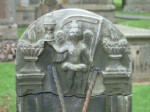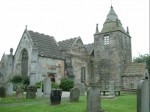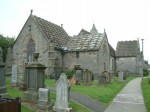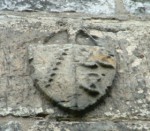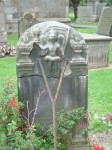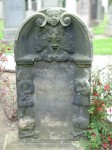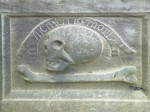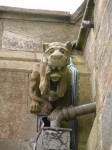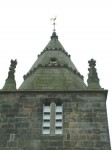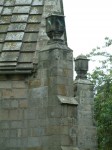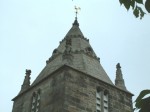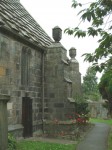Corstorphine Collegiate Church
This is another collegiate church which falls into the same mould as Rosslyn Chapel – established by a locally powerful family, the Forresters, who had a castle nearby. The castle no longer exists.
- Corstorphine Church from the north west.
- Corstorphine Church from the north east
- Coat of Arms
- Gravestone
- Gravestone
- Memento Mori
- Gargoyle
- Corstorphine Collegiate Church tower
- Corstorphine Collegiate Church pinnacles
- Corstorphine Collegiate Church tower
- Corstorphine Collegiate Church (S.W.)
The collegiate church developed from a chapel which was situated within the grounds of the parish church. In 1426 the foundation of three chaplaincies was confirmed under the Great Seal of Scotland. Two further chaplains and two clerks were added in 1429 and a charter containing these details confirms that the founding of a collegiate church was founded in that year by Sir Adam Forrester. Unfortunately, the actual charter is no longer extant. The church contains a fine effigy of the founder. In common with other families which owned collegiate churches (like Rosslyn Chapel) members of the family were buried in the vaults below the main chapel. This confirms the purpose of the church was the same as that of Rosslyn Chapel – the saying of prayers for the souls of family members as well as a family burial place.
On or about 26th June 1436 a petition to appropriate the parish of Ratho, and its revenues, for the support of an additional four or five priests for the the collegiate church, which that petition describes as already having a Provost, four priests and two choristers. This petition was reinforced by another submitted to the Pope which was dated 7th January 1437.
The scheme to join Ratho with Corstorphine does not appeared to have taken place for we find that the union was again suggested in 1443 when five additional Chaplains were to be added to the collegiate church one of whom was to be stationed at Ratho.
Another petition dated 10th June 1444, by Sir John Forrester (son of the founder Sir Adam), indicates that the previous arrangements had not been implemented, at least not in full. Sir John’s petition envisioned the collegiate church would have nine priests and two choir boys.
The number of prebendaries varied over time with a minimum of five and a maximum of nine. In this Corstorphine Collegiate Church was on a par with Rosslyn Chapel which had a maximum of six prebendaries at any one time.
A bull of Pope Eugenius IV (reigned 1431-1447), sanctioned on 30th October 1444, seems to have finally settled the matter. The Bishop of St Andrews, implementing the Papal bull, added four chaplains rather than the five originally intended. This bull also detailed the endowment for each of the eight prebendaries which continued until the collegiate church was suppressed at the Reformation where after it was adapted for use as a reformed place of worship.
